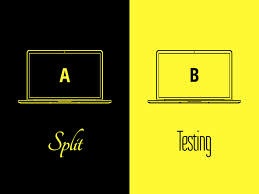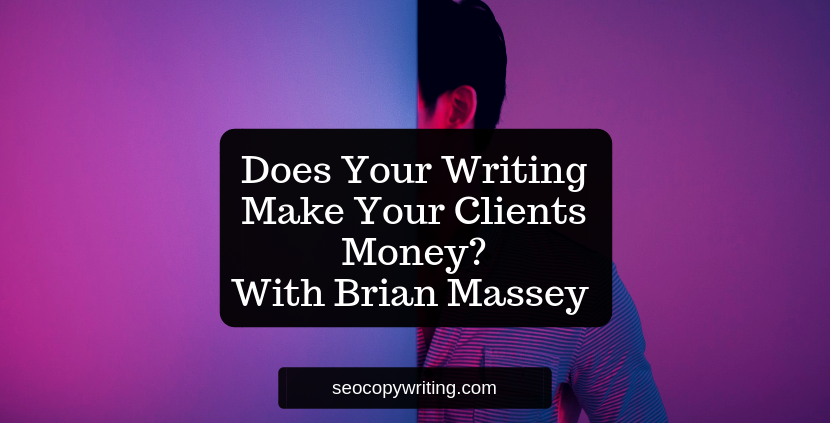Does Your Writing Make Your Clients Money? With Brian Massey

Rock conversions with A/B split testing!
Brian Massey is known as “The Conversion Scientist” for good reason, beyond the trademark and his signature lab coat. He has immersed himself in the science of conversions-driving online content for over 20 years, founded on hard data gleaned from analytics and testing.
We caught up with Brian to ask him about A/B conversion testing, as well as how and why writers should add this skill set to their offerings. His responses are candid and rich with details – you’ll want to savor and bookmark this one!
Some writers believe that A/B conversion testing is too technical. How would you help an A/B testing newbie get over this perception and start testing with glee?
I’ve always written for the beginner. I want to introduce them to that “glee”: that moment when they realize they can stop guessing about what they should put on the page.
Expensive writers are tested writers. They can claim having created unbeaten controls, and revenue improvements with their writing.
I would recommend that any writer serious about persuasion make it a part of their offering. This means that they need to raise prices. “I’ll write for you, but I insist on measuring my improvement. I want you to keep using me to make money.”
Yes, you will have to charge more, but what better incentive to test than to have promised a tested body of copy at a high price? Don’t make any guarantees, but withhold the option of doing another test at your discretion.
Be ready to lose. It happens.
Choose a money page and do a split-URL test in which you create two pages to test. Google Experiments (part of Google Analytics) or Unbounce for landing pages support these kinds of tests. See if your copy can really beat what they have.
There are a lot of helpful resources on the Web. Start at The Conversion Scientist blog to learn how to do these tests.
Once you become a tested writer, you get to add more zeros to your fee.
What’s the basic process for A/B conversion testing?
You have to be writing to accomplish a specific task: a purchase, a subscription, a download, a phone call, etc.
When we write, we keep in our head a list of things we want to bring to bear on the persuasive problem:
“I should use a direct lead.”
“I should introduce scarcity.”
“I should generate a graph of the results data.”
“I should integrate a customer story.”
Write these down as a list of hypotheses:
“A direct lead will get more readers to my benefits section, increasing phone calls.”
“Scarcity will incite more of my readers to convert.”
“A graphic will accelerate understanding of our value proposition and increase subscriptions.”
“A customer story will get more people to read the page and generate more purchases.”
Pick the ones you think will have the biggest impact on the control — the current page. Of these pick the easiest to test.
“Changing the headline to a direct lead” is easy to test and often highly impactful.
Create a copy of the control. Make the headline change. Then do your split URL test using one of the tools I talked about before — Google Experiments and Unbounce:
What you are looking for is a statistically significant winner of the two. The tools guide you to making this call.
If your change wins, the client will be happy to be making more money, and you move on the next hypothesis in your list.
What elements should a writer test? Is there any particular order of relevance (for instance, headlines first, then the CTA…)?
We find our biggest wins from the words we test. Headlines, calls to action, risk reversal language and trust symbols.
In general, the first things we look for are:
- Does the headline keep the promise made by the ad, link or social media post that brought the visitor to the page. If not, fix it.
- Are you asking the visitor to do something on the page? Is it written in terms of what they will get when they take action?
- Have you eliminated risk by reversing it? Do you offer a guarantee, free shipping, quality service? Prove it with the words.
- Did you choose images that move the value proposition forward? On the web, no writer worth their salt ignores images, or lets the web designer pick the images for them. Images are part of persuasive writing. If you can’t write a persuasive caption for an image, it doesn’t belong on the page.
Is there any conversions testing software you’d recommend?
Every writer should be familiar with a click-tracking and session recording program.
Your hypotheses can be measured in scrolls and clicks. How far are my readers scrolling? Where are they clicking? What aren’t they seeing?
When you launch a new body of copy or a new headline, your clients are going to go and look at Google Analytics to see if their conversions increased when your page launched. Don’t get caught off guard. You have to be familiar enough with this tool to know if your copy made the difference, or if some market effect coincidence hit.
For landing pages, use something like Unbouce to quickly get alternatives tested.
We use Visual Website Optimizer and Optimizely for our split testing. These are inexpensive, effective and flexible. Open free accounts and try your hand.
How long does it usually take before you begin to see significant/measurable results from tweaks to copy?
It depends on the number of transactions you are tracking. You can run a test each month with about 300 transactions a month. Higher trafficked sites may be able to test twice a month.
Our introductory service is six months and works on almost any site with 300 or more transactions a month.
I wouldn’t test tweaks. Big changes such as headlines, calls to action and images should be tested first.
It’s OK to do a rewrite of an entire page, but it is risky. You will have changed some things that increased conversion rates, and some that decreased them. You never know what worked — or didn’t — without a stepwise testing process.
But that turns a month-long copywriting project into a six-month copy-testing project.
Could you share a story or case study about how a small change to copy made all the difference in conversions?
We optimize a number of sites serving addiction treatment centers. Our goal is to get visitors to call, “to take real action” as one of our winning calls to action states.
We did a headline test for one of these clients that included an extreme corner case.
The typical headline reads “Ready to start healing?” We tested this against a more direct headline: “Speak with a compassionate rehab specialist.”
Then we added another page with an extreme test. We like to test corner cases. “Are you ready to stop lying? If so, we can help.”
The “Compassionate rehab specialist” headline delivered a 32% increase in calls over the control, “We can help.” This sort of win is HUGE for our clients.
BUT, the outlier, “Ready to stop Lying?” delivered a 43% increase.
Over the years of working with these clients, tests like these have moved their call conversion rates in to the double digits, most of it with copy.
By the way, if you want to increase phone calls, put the phone number into the headline. Each of the above was followed by “Call #####.”
If a content writer wanted to offer A/B conversion testing as a part of their services, how could she figure out what to charge?
The most basic part of the value proposition is the ROI. If they optimize the copy, and there was a 10% increase in revenue, how much more money would the client make in a year?
Some portion of this should be invested in conversion rate optimization (CRO).
For example, if a landing page is generating $1 million a year, a 10% increase translates to $100,000 in additional annual sales. Is it a bargain if the optimized copy costs $10,000? I think so.
Last year, we averaged a 23.4% increase in leads and sales for our clients over the first six months. This is enough to cover our costs and put a considerable amount of money in our client’s pocket.
In some cases, we had to work extra hard to achieve the gains. Be ready to keep working if your first copy pass doesn’t move the needle.
If you decide to be the conversion copywriter, call me. We will have some work for you.
How could a newbie learn more about A/B conversion testing? Can you recommend specific blogs and columns to read, or people to follow?
There are a number of learning curves you need to get up to be a copy testing superstar.
An Attitude Adjustment: The foundational book Your Customer Creation Equation sets the stage for optimization, making sure that you’ve developed an ecosystem that can be optimized. Plus, I’m on the cover.
Reading tea leaves in Analytics: I recommend Avanash Kaushik’s blog (Occams Razor) and my Marketing Land Column as resources for this.
Developing Hypotheses to Test. The ConversionXL blog is a great resource for best practices on many topics.
Testing: Tim Ash’s Landing Page Optimization is a good primer for how to design a test. Chris Goward’s You Should Test That is another great place for understanding test design and interpretation.
The bottom line is that there are lots of resources out there now on conversion optimization. Enjoy!
You can connect with Brian via Twitter and Google+.




“Once you become a tested writer, you get to add more zeros to your fee.” That’s the spirit!! :)